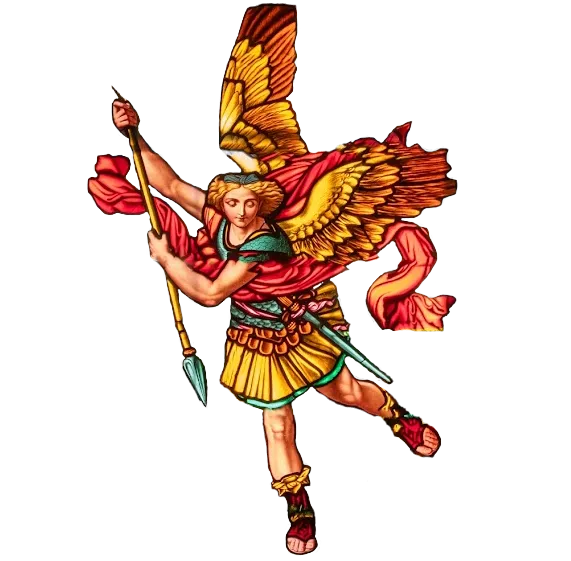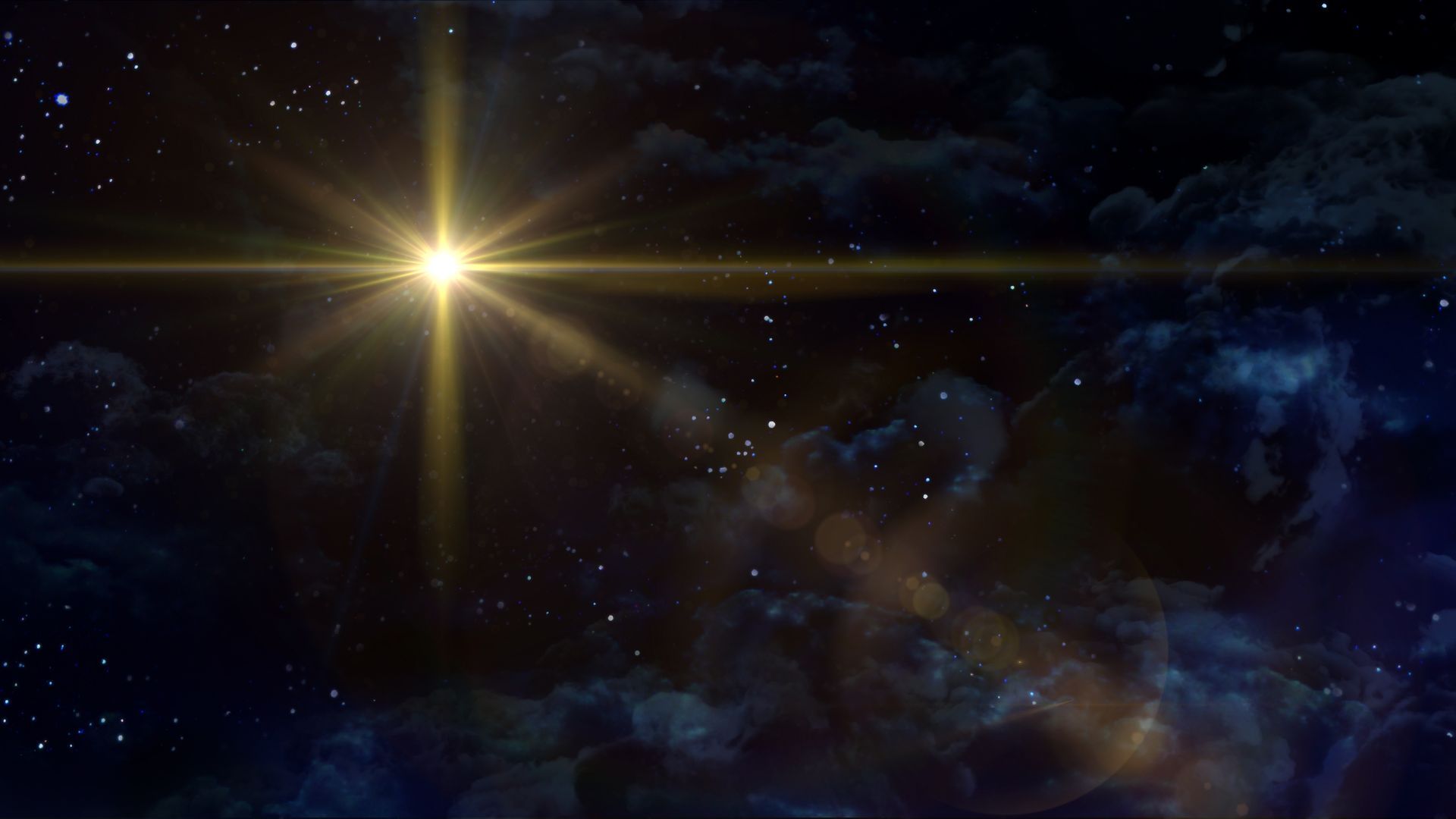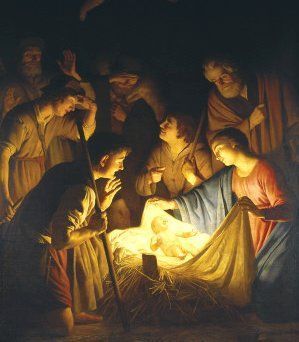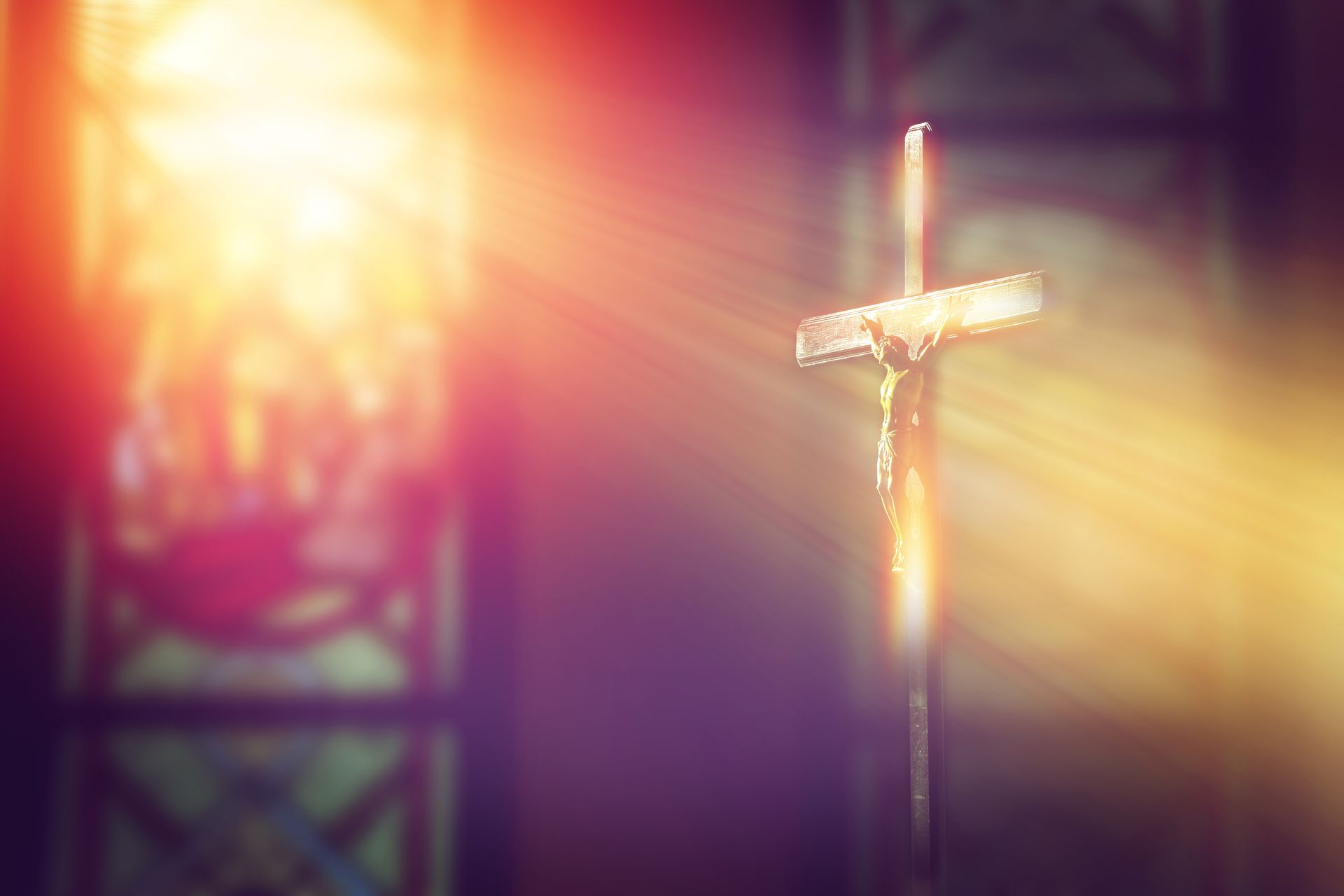The Christmas Season of the 2025 Liturgical Calendar is the evening of December 24th, 2025 through January 11th, 2026.
The Christmas Season
Christmas is one of the most important days of the Church year, second only to Easter itself. It is the feast of the incarnation, the feast of God becoming flesh (the Latin "in carne" means "enfleshment"). It is a uniquely Christian teaching, the Divine choosing to become one of us. Because of this belief, God is not only Transcendent, but also wholly Immanent, Emmanuel (God-with-us). While remaining Transcendent (meaning we must rise above our present condition to reach Him), He is at the same time Immanent (meaning He is with us as we rise toward Him).
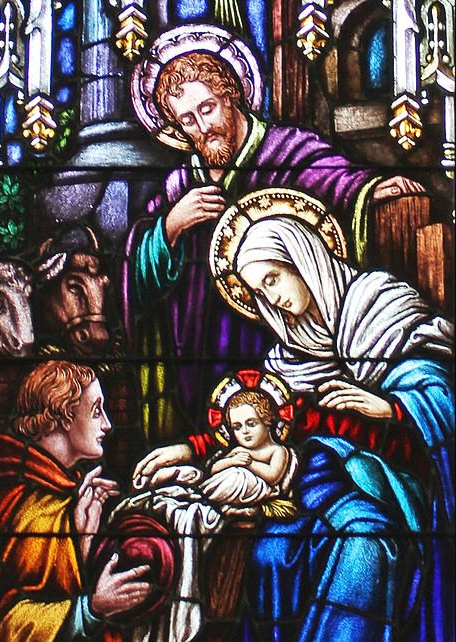
Every Eucharist is like Christmas where the bread and wine are transformed into His flesh, His Body and Blood, and, in a sense, He is born anew on the altar.
The liturgical season of Christmas begins with the vigil Masses on Christmas Eve and concludes on the Feast of the Baptism of the Lord. During this season, we celebrate the birth of Christ into our world and into our hearts, and reflect on the gift of salvation that is born with him…including the fact that he was born to die for us.
The Christmas tree and the Nativity scene are popular symbols of the season and a tradition in many Christian homes. It is also traditional to exchange Christmas gifts with family and friends as a way to honor God the Father's gift of his only son to the world. Having received the gift of Christ, we naturally want to pass that gift along to our loved ones.
-United States Conference of Catholic Bishops
Behold, the virgin shall be with child and bear a son, and they shall name him Emmanuel,” which means “God is with us.”
Matthew 1: 23
The First Nativity Scene
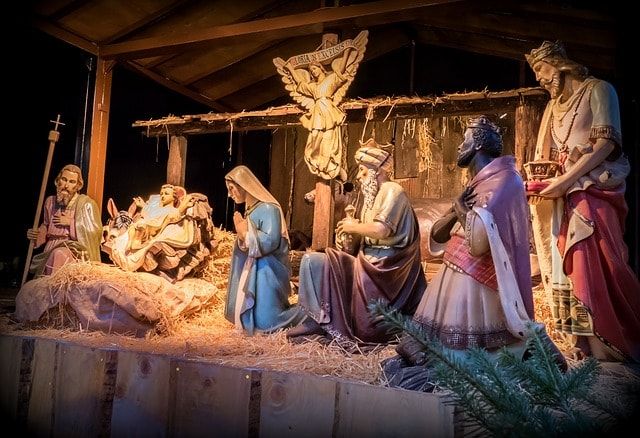
Nativity scenes have been a popular Advent and Christmas decoration for centuries, and—like most things glorious, time-honored, and holy—it originated with a Catholic saint.
Saint Francis of Assisi had a special devotion to the Child Jesus, and he is credited with creating the first nativity scene on Christmas Eve of the year 1223.
It is believed that Saint Francis was first inspired by this idea after visiting the historical place of Christ's birth on a pilgrimage to the Holy Land—the humble stable in a Bethlehem cave. It is likely this event deepened his devotion to the Child Jesus, who was born into the world in such poverty, humility, and simplicity. In fact, Francis founded his new religious Order (Franciscan Order) to imitate these very virtues.
Saint Francis recreated the scene of Christ's birth in a special ritual and Mass he held inside of a cave in Greccio, Italy, inviting both his fellow friars and the townspeople to join in the celebration.
Later he told a friend why he desired to create the first nativity scene in his town:
"I want to do something that will recall the memory of that Child who was born in Bethlehem, to see with bodily eyes the inconveniences of his infancy, how he lay in the manger, and how the ox and ass stood by."
He set up an empty manger (the feeding trough of farm animals which served as Jesus' crib) inside a cave, and even included a live ox and donkey beside the manger just as it was believed to have happened on that first Christmas night. Through these visual aids he wanted everyone to impress more deeply into their understanding how Christ came into the world in such poverty and simplicity. This was a typical perspective of Saint Francis' unique charism of simple, poverty-centered spirituality.
It is also said that Saint Francis—who was radically devoted to the virtue of evangelical poverty—was inspired to recreate the original nativity scene to overcome the rampant greed and materialism prevalent at that time in Italy
What a beautiful scene! Each time we meet at our churches for a nativity pageant or live nativity scene, or around a nativity decoration for a time of prayer, we are participating in a centuries-old Catholic tradition.
Saint Francis' recreation of that first Christmas night was so popular that soon every church in Italy had its own nativity scene. The devotion also spread to private homes, and in modern times even to secular institutions, so much so that it's now impossible to imagine Christmas without a nativity scene to behold.
Hopefully this story of the first nativity scene will inspire you to see your nativity set as much more than just as a pretty Christmas decoration. It is a historic Catholic tradition and a tool for meditation on the humility, simplicity, and poverty of Christ that he took on, from the moment of his Incarnation, out of his boundless love for his lost sheep.
© The Catholic Company. All rights reserved.
Blessing of the Creche
The blessing of the Christmas manger or nativity scene may take place on the Vigil of Christmas or at another suitable time.
When the manger is set up in the home, it is appropriate that it be blessed by a parent or another family member.
All make the sign of the cross as the leader says:
Our help is in the name of the Lord.
R/. Who made heaven and earth.
One of those present or the leader reads a text of sacred Scripture, for example, Luke 2:1 (lines 1-8) or Isaiah 7:10 (lines 10-15, the birth of Emmanuel).
Reader: The Gospel of the Lord.
R/. Praise to you, Lord Jesus Christ.
The leader prays with hands joined:
God of every nation and people,
from the very beginning of creation you have made manifest your love: when our need for a Savior was great you sent your Son to be born of the Virgin Mary.
To our lives he brings joy and peace, justice, mercy, and love.
Lord,
bless all who look upon this manger; may it remind us of the humble birth of Jesus, and raise our thoughts to him, who is God-with-us and Savior of all, and who lives and reigns forever and ever.
R/. Amen.
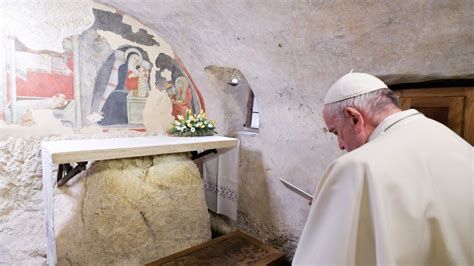
Revive a Tradition
On Sunday, December 1, 2019, Pope Francis returned to the town of Greccio, Italy where Saint Francis of Assisi created the first Nativity scene in the year 1223.
The Pope wrote an apostolic letter, Admirabile Signum, in which he said
“The depiction of Jesus’ birth is itself a simple and joyful proclamation of the mystery of the Incarnation of the Son of God.”
“The nativity scene is like a living Gospel rising up from the pages of sacred Scripture,” contemplating the Christmas story is like setting out on a spiritual journey, “drawn by the humility of the God who became man in order to encounter every man and woman.” So great is His love for us, writes the Pope, “that He became one of us, so that we in turn might become one with Him.”
The Pope hopes this Letter will encourage the family tradition of preparing the nativity scene, “but also the custom of setting it up in the workplace, in schools, hospitals, prisons and town squares.”
Praising the imagination and creativity that goes into these small masterpieces, Pope Francis says he hopes this custom will never be lost “and that, wherever it has fallen into disuse, it can be rediscovered and revived.”
The Christmas Tree
For thousands of years, the evergreen tree has been a sign of hope and life. For ancient people, it was a reminder in the winter that sunlight and good weather would come again. For Christians, it's a reminder that Jesus came to bring us the hope of eternal life.
While sixteenth century Germans are said to be the first people to bring Christmas trees into their homes,
Saint Boniface, an eighth century Catholic missionary to the Germans, is credited with creating the first Christmas tree. This happened one Christmas Eve when he chopped down a large oak tree that the Germans used for pagan worship. He pointed to a nearby evergreen tree, saying that it represented peace and eternal life. He told the crowd of Germans to gather around evergreen trees in their homes in a spirit of kindness and love, to commemorate the child Jesus.
In the early 1800s, German settlers brought the Christmas tree tradition to Pennsylvania. The rest of America adopted the tradition in 1846, and slowly but surely the Christmas tree gained popularity. Now, Christmas trees are seen in homes and on display all over the world. Their beauty and light remind us of the hope we have in Jesus.
Why Do We Decorate with Lights?
Candles and lights are prevalent at Christmas time. Glowing warmly at the darkest time of year, they symbolize the light of Jesus shining through the darkness of sin and death.
Today’s strings of electric Christmas lights evolved from candles. It’s not clear when candles first became a Christmas tradition, but one historical record mentions that a large candle was used in the Middle Ages as a symbol of the star of Bethlehem.
During the 1500s, Christians began using candles to decorate their Christmas trees. The flickering glow of the small flames amid the evergreen branches created a beautiful image of hope, but it was a fire hazard. In 1882, Thomas Edison’s friend Edward H. Johnson created the first string of electric Christmas lights, making it much safer for people to light their trees.
-DynamicCatholic.com
Blessing of the Christmas Tree
The use of the Christmas tree is relatively modern. Its origins are found in the medieval mystery plays that depicted the tree of paradise and the Christmas light or candle that symbolized Christ, the Light of the world. According to custom, the Christmas tree is set up just before Christmas and may remain in place until the Solemnity of Epiphany. The lights of the tree are illuminated after the prayer of blessing.
In the home the Christmas tree may be blessed by a parent or another family member, in connection with the evening meal on the Vigil of Christmas or at another suitable time on Christmas Day.
When all have gathered, a suitable song may be sung.
The leader makes the sign of the cross, and all reply “Amen.”
The leader may greet those present in the following words:
LEADER: Let us glorify Christ our light, who brings salvation and peace into our midst, now and forever.
R/. Amen.
In the following or similar words, the leader prepares those present for the blessing:
LEADER: My brothers and sisters, amidst signs and wonders Christ Jesus was born in Bethlehem of Judea: his birth brings joy to our hearts and enlightenment to our minds. With this tree, decorated and adorned, may we welcome Christ among us; may its lights guide us to the perfect light.
One of those present or the leader reads a text of sacred Scripture, for example, Titus 3:4 (lines 4-7) or Ezekiel 17:22 (lines 22-24 4; I will plant a tender shoot on the mountain heights of Israel.)
Reader: The Word of the Lord.
R/. Thanks be to God.
After the intercessions the leader invites all present to say the Lord’s Prayer. "Our Father..."
The leader says the prayer with hands joined:
LEADER:
Lord our God,
we praise you for the light of creation:
the sun, the moon, and the stars of the night.
We praise you for the light of Israel:
the Law, the prophets, and the wisdom of the Scriptures.
We praise you for Jesus Christ, your Son:
he is Emmanuel, God-with-us, the Prince of Peace,
who fills us with the wonder of your love.
Lord God,
let your blessing come upon us
as we illumine this tree.
May the light and cheer it gives
be a sign of the joy that fills our hearts.
May all who delight in this tree
come to the knowledge and joy of salvation.
We ask this through Christ our Lord.
R/. Amen.
The lights of the tree are then illuminated.
The leader concludes the rite by signing himself or herself with the sign of the cross and saying:
LEADER:
May the God of glory fill our hearts with peace and joy, now and forever.
R/. Amen.
The blessing concludes with a verse from “O Come, O Come, Emmanuel”:
O come, thou dayspring, come and cheer
our spirits by thine advent here;
disperse the gloomy clouds of night
and death’s dark shadow put to flight.
Rejoice! Rejoice! Emmanuel
shall come to thee, O Israel.



